Four Days in San Pedro de Atacama - A Desert Oasis

The smaller of two of Chile´s finer towns to be named after the country´s founder, Conquistadore Pedro de Valdivia, San Pedro, was a relaxing end to a hectic week or two of intense travel. Valdivia came through here on his way south from Peru in 1541, in search of more silver and gold. The Spanish appetite for precious metals never was fully sated. He didn´t find much but by the time of his death twelve years later, he had put most of the long strip of land to the west of the Andes under Spanish control.
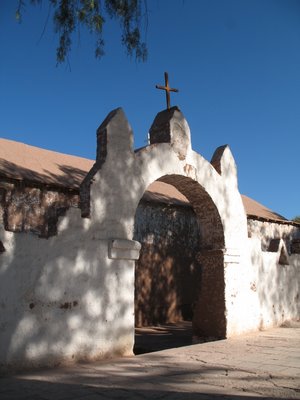
The first two days I didn´t do much apart from wander the streets, visit the small but excellent museum, buy some souvenirs and eat and drink myself back to top form. The restaurants and bars aren´t cheap here but they do offer something quite unique to this sort of gringo town. One day you can be lunching on an excellent steak listening to some cool house music, later you might be in the internet cafe enjoying classic MTV acoustic sets from the likes of Nirvana and Alice and Chains. The evenings tended to be social affairs, where gathered somewhere quiet and enjoyed some of the country´s fine wines, eating anything from Mexican to French food, whilst the waiter mixed up his favourite Pink Floyd CDs or whatever took his fancy on that particular night. Some mochileros sneer at this, but they tend to be the unusual sorts, who don´t appreciate the rich fusion of Chilean and backpacker culture you get here. This is the sort of town you plan to quickly pass through in two or three days, yet end up staying four or five.
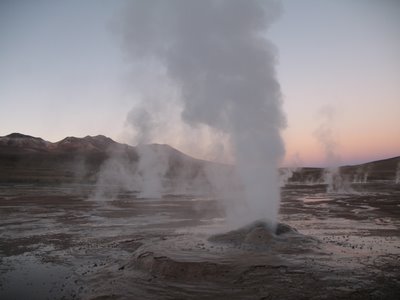
On the third day, I did the two most popular half trips in one long busy day, first rising at 4am, to visit the Tatio Geyser field up at 4300m. Chileans claim its the world´s highest, but sol de manaña in Bolivia is actually about 500m higher even though its a much smaller geyser field and perhaps more of a collection of fumaroles. The sight of the steam rising up from the geysers at sunrise was truly an amazing sight. As well as active geysers, there were dormant ones which have burnt themselves out over time, fumaroles and mud pools - many of which were brightly coloured with orange iron, green copper or yellow sulphurous deposits. These hot pots are home to various varieties of extremophiles, unusual bacteria which can live at high temperatures or in high mineral content solutions, often by using novel biochemical pathways not present in higher organisms. We also had a quick chance to have a quick dip in the thermal waters - definitely the best natural setting for a thermal baths that I have ever seen.
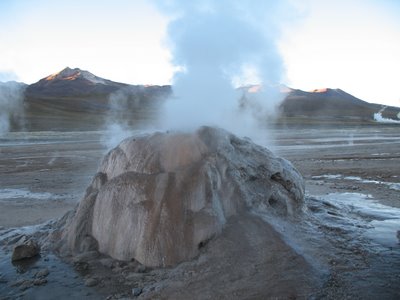

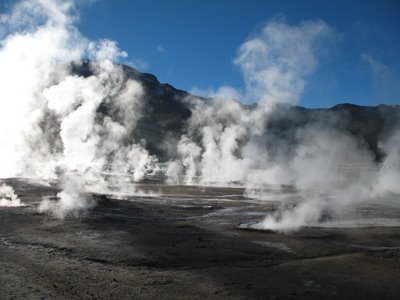
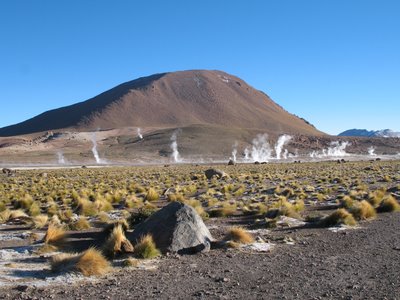
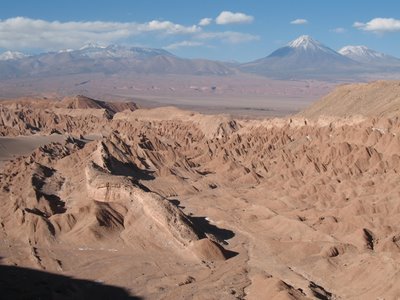
Later that day, I took another tour that visited Chile´s version of valle de la luna, a series of lunar landscapes, where the panoptic vistas really do make you feel like you´re on another planet. Particularly impressive was walking down through the valley of the dead and then watching the sunset from atop a huge sand dune over the valley of the moon. I have seen better sunsets, but as the horizon turned a fuzzy orange purple colour, the realisation dawned that they have not been from such a dramatic setting as as this.

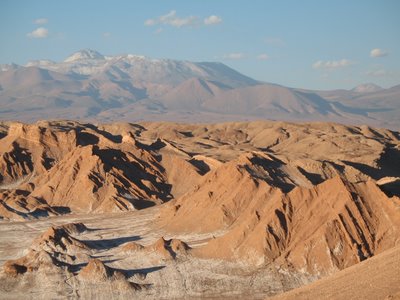
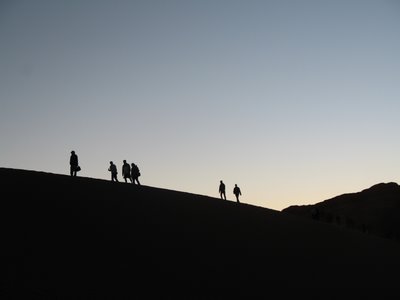

The first two days I didn´t do much apart from wander the streets, visit the small but excellent museum, buy some souvenirs and eat and drink myself back to top form. The restaurants and bars aren´t cheap here but they do offer something quite unique to this sort of gringo town. One day you can be lunching on an excellent steak listening to some cool house music, later you might be in the internet cafe enjoying classic MTV acoustic sets from the likes of Nirvana and Alice and Chains. The evenings tended to be social affairs, where gathered somewhere quiet and enjoyed some of the country´s fine wines, eating anything from Mexican to French food, whilst the waiter mixed up his favourite Pink Floyd CDs or whatever took his fancy on that particular night. Some mochileros sneer at this, but they tend to be the unusual sorts, who don´t appreciate the rich fusion of Chilean and backpacker culture you get here. This is the sort of town you plan to quickly pass through in two or three days, yet end up staying four or five.

On the third day, I did the two most popular half trips in one long busy day, first rising at 4am, to visit the Tatio Geyser field up at 4300m. Chileans claim its the world´s highest, but sol de manaña in Bolivia is actually about 500m higher even though its a much smaller geyser field and perhaps more of a collection of fumaroles. The sight of the steam rising up from the geysers at sunrise was truly an amazing sight. As well as active geysers, there were dormant ones which have burnt themselves out over time, fumaroles and mud pools - many of which were brightly coloured with orange iron, green copper or yellow sulphurous deposits. These hot pots are home to various varieties of extremophiles, unusual bacteria which can live at high temperatures or in high mineral content solutions, often by using novel biochemical pathways not present in higher organisms. We also had a quick chance to have a quick dip in the thermal waters - definitely the best natural setting for a thermal baths that I have ever seen.





Later that day, I took another tour that visited Chile´s version of valle de la luna, a series of lunar landscapes, where the panoptic vistas really do make you feel like you´re on another planet. Particularly impressive was walking down through the valley of the dead and then watching the sunset from atop a huge sand dune over the valley of the moon. I have seen better sunsets, but as the horizon turned a fuzzy orange purple colour, the realisation dawned that they have not been from such a dramatic setting as as this.



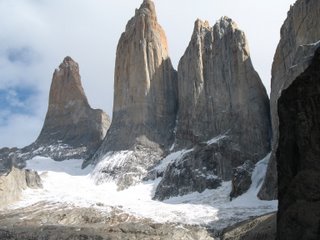

0 Comments:
Post a Comment
<< Home